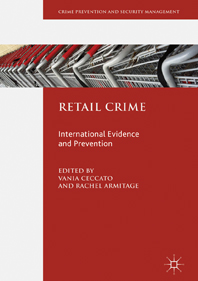Author: Editors: Vania Ceccato, and Rachel Armitage
ISBN No: 978-3-319-73064-6 (hardback; also sold as ebook)
Review date: 25/04/2024
No of pages: 424
Publisher: Palgrave
Publisher URL:
https://www.palgrave.com/us/book/9783319730646
Year of publication: 26/07/2018
Brief:
In a world changing in bewildering ways and at bewildering speed, one seeks reassuringly familiar things. One of those is Palgrave’s Crime Prevention and Security Management series of books, edited overall by Prof Martin Gill.
Among the most recent publications is Retail Crime, with UK (Prof Rachel Armitage of Huddersfield) and Swedish (Prof Vania Ceccato) editors.As that mix would suggest, the book has chapters devoted to the UK and international aspects of crime against retail, besides a chapter by the long-time UK independent retail and loss prevention academic Prof Joshua Bamfield, titled ‘International Trends in Retail Crime and Prevention Practices’. As he says, while retailers are treating LP (loss prevention) as an element of ‘corporate performance’ – so that we could say LP has come of age – as Joshua (who gets plenty of citations by other authors in the collection) adds, meanwhile ‘resources are tightly stretched’, just as to the problem of theft by employee insiders are added cybercrime and theft by organised crime groups. Hence a new approach to LP, stressing risk management, to curb total losses (rather than chasing totals of arrests of suspects) by ‘a combination of risk management approaches and higher cost and resource pressures’.
To turn briefly to another book recently reviewed, Disrupt and Deny by the historian of British covert action – spies and special forces – Dr Rory Cormac pointed out how covert action since 9-11 has become a matter of risk management, too.
Some of the chapters in Retail Crime may be too specialised for your particular taste or interest, such as cargo theft in Sao Paulo, or organised theft of medicines from Italian hospitals; or shoplfiting from small stores in perth, Western Australia; or retail theft in a Swedish shopping centre, by Ceccato. Hence the new-fangled ability to buy single chapters electronically, cheaper than buying the whole book, may come in handy, whether you want to focus on a particular country, or a chapter that suits your MSc study.
Two free open access chapters (chapters 8 and 9) are available on SpringerLink: https://bit.ly/2Itmh3o.
To address UK readers, then, they may find a chapter by Huddersfield academic criminologist Andrew Newton particularly useful or intriguing, for as he says, railway stations have become retail destinations (to leave him for a moment, think of St Pancras International, let alone the new Birmingham new Street). Research into shoplifting at rail stations is as Newton says, both timely and necessary, whether your interest is comparing the trends in shop theft generally with neighbouring railway stations, or to learn what rail hubs are hit by shoplifting more than others, or what sort of retail at a rail hub is getting hit most.
As the opening chapter that sets the scene says, the book is written in terms of situational crime prevention; but retail crime has changed as the technology in retail has changed, as shown most obviously in the chapter on self-service at checkouts, by the City, University of London criminologist Emmeline Taylor. The way we pay at the PoS (point of sale) is changing, because although (as Taylor says) there’ll likely be a place for the member of staff at check-out ‘for the foreseeable future’, COPS (customer operated payment systems) means savings and more speed when paying for goods; but what of the ability to avoid payment or to under-pay for what’s in our basket?! Despite the opportunities for customers to cheat, might self-checkout be on the whole better in terms of LP – that is, lower losses, if not having staff at the point of sale, or one staffer floating between several terminals rather than one at each makes it harder for a crooked member of staff to do ‘sweet-hearting’ frauds?
Rachel Armitage herself has made a particular study of crime prevention through environmental design (CPTED), for housing in particular, and in this book she co-authors a review of CPTED and retail store layout. Another important chapter from a UK author and perspective is Prof Martin Gill’s, characteristically in terms of ‘what works’ in reducing crime against retail; ‘Views from Retail Loss Prevention Managers and Directors’.
All in all, whatever your interest in crime against retail, here is at least one or two chapters of use, as an update on thinking, that in terms of cost per chapter is value for money. On that score, you may want to start with the final, round-up, chapter.
To sum up, while some things change, the tech most obviously, and there are limits to what we know – as Bamfield sets out, numbers and types of arrest may show the crime prevention activity, rather than the actual kind of crimes against retail – some things hold true, or at least true enough to be worth holding on to and checking against reality, such as the concept of CRAVED – the ‘hot products’ are those that are concealable, removable, available, valuable, enjoyable and disposable. The latest thinking is that what’s stolen depends not only on what the thieves would like to steal, but what they are able to.









